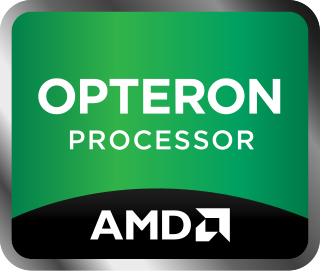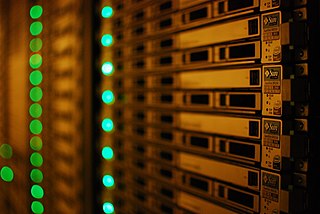Related Research Articles

Advanced Micro Devices, Inc., commonly abbreviated as AMD, is an American multinational semiconductor company based in Santa Clara, California, that develops computer processors and related technologies for business and consumer markets.

Sun Microsystems, Inc., was an American technology company that sold computers, computer components, software, and information technology services and created the Java programming language, the Solaris operating system, ZFS, the Network File System (NFS), and SPARC microprocessors. Sun contributed significantly to the evolution of several key computing technologies, among them Unix, RISC processors, thin client computing, and virtualized computing. Notable Sun acquisitions include Cray Business Systems Division, Storagetek, and Innotek GmbH, creators of VirtualBox. Sun was founded on February 24, 1982. At its height, the Sun headquarters were in Santa Clara, California, on the former west campus of the Agnews Developmental Center.

Silicon Graphics, Inc. was an American high-performance computing manufacturer, producing computer hardware and software. Founded in Mountain View, California in November 1981 by Jim Clark, its initial market was 3D graphics computer workstations, but its products, strategies and market positions developed significantly over time.

Opteron is AMD's x86 former server and workstation processor line, and was the first processor which supported the AMD64 instruction set architecture. It was released on April 22, 2003, with the SledgeHammer core (K8) and was intended to compete in the server and workstation markets, particularly in the same segment as the Intel Xeon processor. Processors based on the AMD K10 microarchitecture were announced on September 10, 2007, featuring a new quad-core configuration. The most-recently released Opteron CPUs are the Piledriver-based Opteron 4300 and 6300 series processors, codenamed "Seoul" and "Abu Dhabi" respectively.
Cray Inc., a subsidiary of Hewlett Packard Enterprise, is an American supercomputer manufacturer headquartered in Seattle, Washington. It also manufactures systems for data storage and analytics. Several Cray supercomputer systems are listed in the TOP500, which ranks the most powerful supercomputers in the world.

System x is a line of x86 servers produced by IBM, and later by Lenovo, as a sub-brand of IBM's System brand, alongside IBM Power Systems, IBM System z and IBM System Storage. In addition, IBM System x was the main component of the IBM System Cluster 1350 solution.

x86-64 is a 64-bit version of the x86 instruction set, first released in 1999. It introduced two new modes of operation, 64-bit mode and compatibility mode, along with a new 4-level paging mode.

Quadrics was a supercomputer company formed in 1996 as a joint venture between Alenia Spazio and the technical team from Meiko Scientific. They produced hardware and software for clustering commodity computer systems into massively parallel systems. Their highpoint was in June 2003 when six out of the ten fastest supercomputers in the world were based on Quadrics' interconnect. They officially closed on June 29, 2009.

Xeon is a brand of x86 microprocessors designed, manufactured, and marketed by Intel, targeted at the non-consumer workstation, server, and embedded system markets. It was introduced in June 1998. Xeon processors are based on the same architecture as regular desktop-grade CPUs, but have advanced features such as support for ECC memory, higher core counts, more PCI Express lanes, support for larger amounts of RAM, larger cache memory and extra provision for enterprise-grade reliability, availability and serviceability (RAS) features responsible for handling hardware exceptions through the Machine Check Architecture. They are often capable of safely continuing execution where a normal processor cannot due to these extra RAS features, depending on the type and severity of the machine-check exception (MCE). Some also support multi-socket systems with two, four, or eight sockets through use of the Ultra Path Interconnect (UPI) bus.
The 90 nm process is a level of MOSFET (CMOS) fabrication process technology that was commercialized by the 2003–2005 timeframe, by leading semiconductor companies like Toshiba, Sony, Samsung, IBM, Intel, Fujitsu, TSMC, Elpida, AMD, Infineon, Texas Instruments and Micron Technology.
Tyan Computer Corporation is a subsidiary of MiTAC International, and a manufacturer of computer motherboards, including models for both AMD and Intel processors. They develop and produce high-end server, SMP, and desktop barebones systems as well as provide design and production services to tier 1 global OEMs, and a number of other regional OEMs.
In the fields of digital electronics and computer hardware, multi-channel memory architecture is a technology that increases the data transfer rate between the DRAM memory and the memory controller by adding more channels of communication between them. Theoretically, this multiplies the data rate by exactly the number of channels present. Dual-channel memory employs two channels. The technique goes back as far as the 1960s having been used in IBM System/360 Model 91 and in CDC 6600.

Adaptec, Inc., was a computer storage company and remains a brand for computer storage products. The company was an independent firm from 1981 to 2010, at which point it was acquired by PMC-Sierra, which itself was later acquired by Microsemi, which itself was later acquired by Microchip Technology.

Sun Fire is a series of server computers introduced in 2001 by Sun Microsystems. The Sun Fire branding coincided with the introduction of the UltraSPARC III processor, superseding the UltraSPARC II-based Sun Enterprise series. In 2003, Sun broadened the Sun Fire brand, introducing Sun Fire servers using the Intel Xeon processor. In 2004, these early Intel Xeon models were superseded by models powered by AMD Opteron processors. Also in 2004, Sun introduced Sun Fire servers powered by the UltraSPARC IV dual-core processor. In 2007, Sun again introduced Intel Xeon Sun Fire servers, while continuing to offer the AMD Opteron versions as well.

The IBM BladeCenter was IBM's blade server architecture, until it was replaced by Flex System in 2012. The x86 division was later sold to Lenovo in 2014.
The AMD Bulldozer Family 15h is a microprocessor microarchitecture for the FX and Opteron line of processors, developed by AMD for the desktop and server markets. Bulldozer is the codename for this family of microarchitectures. It was released on October 12, 2011, as the successor to the K10 microarchitecture.
SGI Virtu is a computer product line from Silicon Graphics dedicated to visualization, announced in April 2008. It represents a return of Silicon Graphics to the visualization market after several years of focus on high-performance computing.
Sun Blade is a line of blade server computer systems sold by Sun Microsystems from 2006 onwards.
AMD Piledriver Family 15h is a microarchitecture developed by AMD as the second-generation successor to Bulldozer. It targets desktop, mobile and server markets. It is used for the AMD Accelerated Processing Unit, AMD FX, and the Opteron line of processors.
References
- ↑ Matt Hudgins (November 18, 2001). "Stealth company coming into open: Newly funded with $27.9M, Newisys Inc. takes 30,000 s.f." Austin Business Journal. Retrieved November 11, 2016.
- ↑ Deni Connor (August 19, 2002). "Start-up to ease move to 64-bit". Network World. Retrieved November 11, 2016.
- ↑ "Form D: Notice of Sale of Securities" (PDF). US SEC. November 23, 2002. Retrieved November 11, 2016.
- ↑ "Form D: Notice of Sale of Securities" (PDF). US SEC. February 13, 2003. Retrieved November 11, 2016.
- ↑ Tony Smith (July 17, 2003). "Sanmina buys Newisys: Rescue bid touted as strategic acquisition?". The Register. Retrieved November 11, 2016.
- ↑ Cade Metz (April 11, 2008). "AMD evaporates CTO post: Hester out. No one in". The Register. Retrieved November 11, 2016.
- ↑ Jan Buchholz (July 25, 2014). "See sprawling Lake Travis mansion set for August auction; no minimum bid". Austin Business Journal. Retrieved November 11, 2016.
- ↑ Scott M. Fulton, III (March 11, 2008). "AMD appoints a former Dell exec as CIO". Beta News. Retrieved November 11, 2016.
- ↑ "Newisys NA-1400". November 5, 2005. Archived from the original on January 14, 2006. Retrieved November 11, 2016.
- ↑ Klaus Fehrle (November 14, 2005). "Newisys to show off Opteron Horus today: SMP that's the one for me". The Inquirer. Archived from the original on November 12, 2016. Retrieved November 11, 2016.
{{cite news}}: CS1 maint: unfit URL (link) - ↑ Rajesh Kota. "HORUS: Large Scale SMP using AMD Opteron processors" (PDF). HyperTransport Consortium. Archived from the original (PDF) on January 13, 2006. Retrieved November 11, 2016.
- ↑ "Adaptec Announces Sale of Its Block-Based Systems Assets and Colorado-Based Technology Center to Newisys, a Sanmina-SCI Company". Press release. Adaptec. January 31, 2006. Retrieved November 11, 2016.
- ↑ Charlie Demerjian (May 9, 2007). "Newisys cuts staff: More than half yesterday". The Inquirer. Archived from the original on November 11, 2016. Retrieved November 11, 2016.
{{cite news}}: CS1 maint: unfit URL (link) - ↑ Ashlee Vance (June 20, 2007). "AOpteron darling Newisys lives!: Just a flesh wound". The Register. Retrieved November 11, 2016.